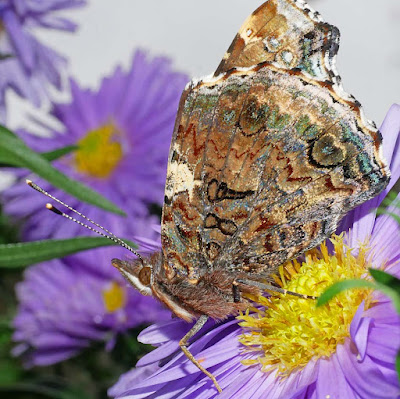Wednesday, September 27, 2023
The Year of the Red Admiral
Sunday, September 24, 2023
Some toadstools from the Tunstall valley, Weardale
It has been a slow start to the toadstool season hereabouts, but these are a few recent finds from the Tunstall valley in Weardale. They were all photographed in or around Backstone Bank wood, an ancient oak woodland. I'm not 100 per cent sure about the identifications, so would welcome any corrections.
Smokey bracket Bjerkandera adusta
Felt saddle Helvella macropus, partially excavated from the leaf litter in the top photo, to reveal the stipe
Friday, September 22, 2023
The first and the last wild rose
Burnet rose Rosa pimpinellifolia is always the first wild rose to come into bloom, in late May, and also the last the continue blooming; I have found it in flower on Christmas day in years when the winter is mild. It's currently putting on a fine early-autumn display at my local nature reserve, Durham Wildlife Trust's Low Barns reserve at Witton-le-Wear. On a chilly autumn day just one sniff of its intense scent takes me right back to warm summer afternoons.
Monday, September 18, 2023
Silver birch seeds
Silver birch seed catkins are ripening now and fall apart at the slightest touch. Their seeds are an important food resource for several small finches, including siskins, goldfinches and redpolls.
Saturday, September 16, 2023
Bumblebees' worn-out wings
By this stage in the year a lot of bumblebees are reaching the end of their lives. They take longer to warm up after cold nights and begin active feeding, and there are fewer flowers available so nectar can be harder to find.
Like many, these have lost quite of lot of their fur and what remains has become sun-bleached. A close look at their wings reveals a lot of wear-and-tear, with fraying at their tips where they have been beating and up to 200 times per second and made contact with hard objects. It's said that the average life of a worker bumblebee is about one month. These are simply worn out, from provisioning colonies that are now in steep decline; soon only the new queens will be left, to crawl away into secure hibernation sites until spring arrives and the whole cycle begins again.
Friday, September 15, 2023
Autumn seed dispensers - beautifully functional natural architecture
Seeds' pods and capsules are remarkable examples of beautiful, functional natural architecture. The two photographs below show what happens when seed pods of American willowherb Epilobium ciliatum are ripe. The pod splits longitudinally into four sections that gradually curl backways, dragging with them the hairy 'parachute' plumes of the rows of seeds, which eventually break free and are carried away on the wind.
Monday, September 11, 2023
The spider season
There are some fascinating spiders around at this time of the year. This little beauty is a zebra spider, that lives in my greenhouse. It doesn't make a web, it leaps on its prey. The forward-facing pair of its eight eyes are especially large, giving it binocular forward vision and the ability to judge distance accurately.



































































